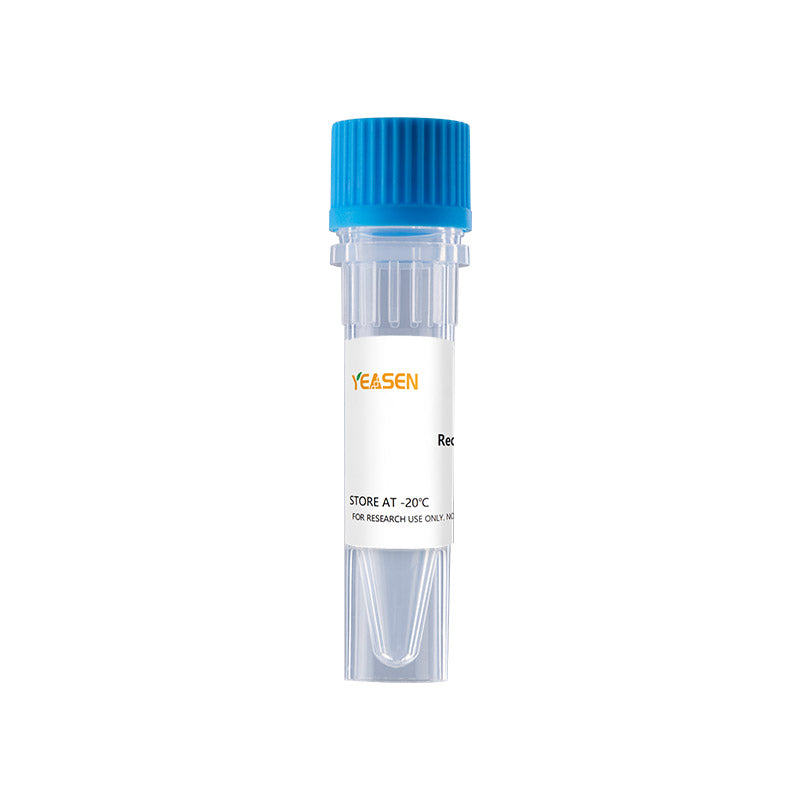Description
Osteoprotegerin (OPG), also called OCIF (osteoclastogenesis inhibitory factor) is a secreted 55-60 kDa protein that regulates bone density. As a member of the tumor necrosis factor receptor (TNFR) superfamily of proteins, it is designated TNFRSF11B. Human OPG cDNA encodes 401 amino acids (aa) including a 21 aa signal peptide and a 380 aa mature soluble protein with four TNFR domains, two death domains and a heparin-binding region. The cysteine-rich TNFR domains are essential for ligand interaction, while a cysteine at the C-terminus mediates homodimerization. Mature human OPG shares 86%, 87%, 92%, 92% and 88% amino acid sequence identity with mouse, rat, equine, canine and bovine OPG, respectively. OPG is widely expressed and constitutively released as a homodimer by mesenchymal stem cells, fibroblasts and endothelial cells. Regulation of its expression by estrogen, parathyroid hormone and cytokines is complex and changes with age. OPG has been called a decoy receptor for the TNF superfamily ligands, TRANCE (tumor necrosis factor-related activation-induced cytokine), also called RANK L (receptor activator of NF kappa B ligand), and TRAIL (TNF-related apoptosis-inducing ligand), which also bind TNF family receptors RANK and TRAIL receptors 1-4, respectively. TRAIL decreases the release of OPG from cells that express it, while OPG inhibits TRAIL-induced apoptosis. Expression of RANK L on the cell surface, and thus its ability to stimulate osteoclastogenesis, is regulated by OPG by intracellular and extracellular mechanisms. Within osteoblasts, interaction of the basic domain of OPG with RANK L in the Golgi inhibits RANK L secretion.
Product Properties
|
Synonyms |
TNFRSF11B, Osteoclastogenesis Inhibitory Factor, Tumor Necrosis Factor Receptor Superfamily Member 11B |
|
Accession |
O00300 |
|
GeneID |
4982 |
|
Source |
E.coli-derived Human OPG, Glu22-Lys194. |
|
Molecular Weight |
Approximately 19.7 kDa. |
|
AA Sequence |
ETFPPKYLHY DEETSHQLLC DKCPPGTYLK QHCTAKWKTV CAPCPDHYYT DSWHTSDECL YCSPVCKELQ YVKQECNRTH NRVCECKEGR YLEIEFCLKH RSCPPGFGVV QAGTPERNTV CKRCPDGFFS NETSSKAPCR KHTNCSVFGL LLTQKGNATH DNICSGNSES TQK |
|
Tag |
None |
|
Physical Appearance |
Sterile Filtered White lyophilized (freeze-dried) powder. |
|
Purity |
> 95 % by SDS-PAGE and HPLC analyses. |
|
Biological Activity |
The ED50 as determined by neutralizing the stimulation of U937 cells is less than 10 ng/mL, corresponding to a specific activity of > 1.0 × 105 IU/mg in the presence of 10 ng/mL soluble rHuRANKL (sRANKL). Fully biologically active when compared to standard. |
|
Endotoxin |
< 1.0 EU per 1μg of the protein by the LAL method. |
|
Formulation |
Lyophilized from a 0.2 μm filtered concentrated solution in 20 mM PB,150 mM NaCl, pH 6.0. |
|
Reconstitution |
We recommend that this vial be briefly centrifuged prior to opening to bring the contents to the bottom. Reconstitute in sterile distilled water or aqueous buffer containing 0.1% BSA to a concentration of 0.1-1.0 mg/mL. Stock solutions should be apportioned into working aliquots and stored at ≤ -20℃. Further dilutions should be made in appropriate buffered solutions. |
Shipping and Storage
The products are shipped with ice pack and can be stored at -20℃ to -80℃ for 1 year.
Recommend to aliquot the protein into smaller quantities when first used and avoid repeated freeze-thaw cycles.
Cautions
1. Avoid repeated freeze-thaw cycles.
2. For your safety and health, please wear lab coats and disposable gloves for operation.
3. For research use only!
Payment & Security
Your payment information is processed securely. We do not store credit card details nor have access to your credit card information.
Inquiry
You may also like
FAQ
The product is for research purposes only and is not intended for therapeutic or diagnostic use in humans or animals. Products and content are protected by patents, trademarks, and copyrights owned by Yeasen Biotechnology. Trademark symbols indicate the country of origin, not necessarily registration in all regions.
Certain applications may require additional third-party intellectual property rights.
Yeasen is dedicated to ethical science, believing our research should address critical questions while ensuring safety and ethical standards.

